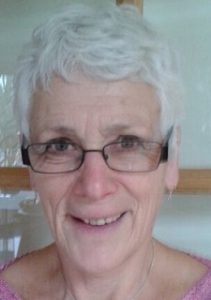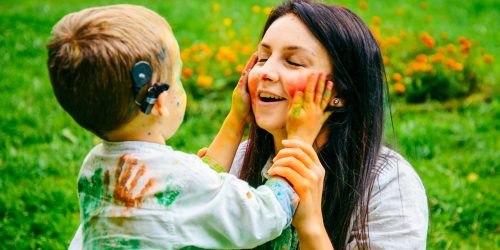The profession of Teacher of the Deaf: status, roles and training – reflections
Personal accounts
A feature of this website is the inclusion of personal accounts of the topic under consideration. This makes it possible to include different perspectives, including accounts from professionals and consumers, and different views on decisions that have been made.
We welcome these contributions at any time, and guidance for contributors is given in the ‘overview of the project‘ section.
We are also happy to include here links to signed contributions.
Click on the link to go directly to the relevant contribution.
Index
- The rather unusual successful education of my sister Rachel and its impact on me – Betsy Chaloner is now retired, she was previously a Teacher of the Deaf and more recently deputy head of a school for the deaf.
- My introduction to deafness and becoming a Teacher of the Deaf – Jennifer Sherwood. Before she retired, Jennifer was a Teacher of the Deaf, an advisory teacher working for more than twenty years with preschool children and their families, and an Acting Head of a School for the Deaf.
- From birth to maturity: the history of BATOD – Bill Chippendale. In 2001 Bill Chippendale, after a rich history in deaf education, was invited to scour the Association archives held at Birmingham University and produce a historical review of the Association. He was awarded the Eichholz prize for this essay. This was the first time the Eichholz Prize had been used in this context.
- You never stop learning; my work as a ToD 1979 – 2016 – Penny McDonald– Regional Tutor/Teaching Practice Co-ordinator University of Leeds, Teaching Practice External Tutor University of Manchester.
- Training as a Teacher of the Deaf at Manchester University 60 years ago – Lester Batchelor is now retired. He was previously a Teacher of the Deaf and Head of Hawkswood School
- My training as a Teacher of the Deaf – Tim Silvester was Principal of the Royal School for the Deaf, Derby from 1991-2005 and previously Head of Services for Deaf and Hearing Impaired Children in Derbyshire.
- My training as a Teacher of the Deaf – Miranda Pickersgill was for many years a Teacher of the Deaf and was Head of Leeds Deaf and Hearing Impaired Service 1987-2000
- The London Institute of Education: Personal Memories 1972-73 – Ted Moore is a former President of BATOD and was previously Head of Sensory Support Services in Oxfordshire.
- The Training of Teachers of the Deaf: the Oxford Course – Tony Fennemore and Liz Andrews. Tony is now retired. He was previously Course Director of the Oxford University Course and prior to that a Lecturer in Special Education. Liz Andrews was Course Director of the Oxford Course for the training of Teachers of the Deaf from September 1989 until 1992 when she joined the Birmingham team working on a distance education version of the programme. She later worked for the Royal National Institute for Deaf people.
- Becoming a teacher of deaf children: the programme at Moray House School of Education, University of Edinburgh – Rachel O’Neill is Director of the MSc Inclusive Education course at the University of Edinburgh. She previously worked in Greater Manchester as a teacher of deaf students.
- University of Hertfordshire: Teacher of the Deaf Programme – Joy Jarvis has been a Teacher of the Deaf and from 1975-2005 she was leader of the course for training Teachers of the Deaf at the University of Hertfordshire.
- The changing landscape for training in deaf education – Ruth Swanwick has been a lecturer/senior lecturer at Leeds University since 1992 when, together with Pam Knight, she developed the course for training Teachers of the Deaf. Prior to that she was a Teacher of the Deaf at the Leeds service for Deaf and Hearing-Impaired pupils.
- Manchester Teacher of the Deaf course, 1968-9 – Sandra Dowe has been a teacher of deaf children, Head of a Hearing Impaired Service, Honorary National Secretary BATOD 1988-1992 and Executive Officer, Deaf Support.
- History of the Department of Audiology and Deaf Education, University of Manchester – Laura Dawes is a Historian of Medicine.
- History of the Mandatory Qualification – 1909 – 2016 Ted Moore is a former President of BATOD and was previously Head of Sensory Support Services in Oxfordshire. We expect to add a further contribution in the near future looking at the courses for training Teachers of the Deaf at Birmingham.
Contents
The first two accounts are from people who trained as Teachers of the Deaf in the late 50s and 60s. Betsy Chaloner had an older sister who was deaf and, observing her mother working with her sister influenced her decision to become a Teacher of the Deaf. Jennifer Sherwood also had a deaf sister and her account provides an interesting comparison between her experience of her sister and her training as a teacher. Both Betsy and Jennifer’s accounts are taken from much longer pieces, fuller versions of which will be put on the website at a later date. In the third account Penny McDonald describes her experiences as a Teacher of the Deaf from 1979-2016 reflecting some of the many changes during that time.In the fourth account, Bill Chippendale provides a history of BATOD and in doing so reflects upon the training and status of Teachers of the Deaf from 1976 onwards. In the following three accounts, Teachers of the Deaf reflect upon various aspects of their training and the impact on the teaching. Lester, in his account reflects on the fact that he trained to be a Teacher of the Deaf alongside new graduates who had no previous experience of teaching. Tim Silvester describes his experience of a course which was largely provided by the school where he was teaching and Miranda Pickersgill reflects upon the medical model of her course.Ted Moore, Tony Fennemore together with Elizabeth Andrews, Rachel O’Neill, Joy Jarvis and Ruth Swanwick describe the development of particular courses: London, Oxford, Moray House, Hertfordshire and Leeds focusing on specific issues raised by these various provisions. Ted describes his own experience as a student but also includes information about the London course after that date. Tony and Elizabeth describe the different stages of the Oxford course while Rachel talks of some of the specific issues facing the development of the Moray House course. Joy talks of difficulties in recruitment of students as schools and services found it increasingly difficult to release students. Ruth discusses changing attitudes to courses encompassing a sign bilingual philosophy.Sandra Dowe, in her piece, looks at the training offered by Manchester in the late 1960s. While she praises the new developments and the training in audiology and speech, she reflects on the omission and understanding of the role of sign language from the course.Laura Dawes contribution was prepared as part of the celebration of the Manchester University course and briefly reviews its history.
Ted Moore adds a useful account about the history and current status of the mandatory qualification.
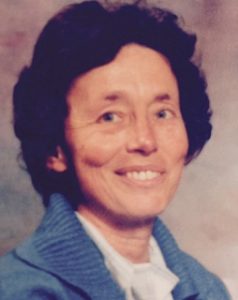
The approach was of course totally oral, without any signing and even gesture completely forbidden The Ewings certainly gave my mother a very thorough grounding on how to help Rachel. How to talk so as to make lip reading as easy as possible (light on own face, no exaggeration etc.) On phonetics – breath and voiced sounds and how to teach them. On reading and how to start this with Rachel. My mother was also encouraged to make use of any residual hearing that Rachel had by talking into her ear – no hearing aids in those days.
Betsy Chaloner then goes on to describe how her sister was educated, and how she participated fully in the life of the private school (for hearing pupils) she attended, listening to stories, taking part in school plays etc. She took her school certificate getting credits in English language and literature. After leaving school she went on to technical college and did courses in typing, cooking and child care continuing to read voraciously whenever she could.
I went on to teach deaf children, at first in the Old Kent School Road for the Deaf. I was, like my mother before me surprised and shocked by the standard of the children’s language levels, lipreading ability, and speech. However, I was very lucky to get enormous help from the school’s great head teacher, Molly Johnson, so that I had a good head start when I went to Manchester for my further training with the Ewings.
After a year of lectures, teaching practice, auditory training, taking lessons in front of fellow students (what a nightmare!), and taking individual lessons for speech training, I returned to the Old Kent Road to start my career as a teacher of deaf children in earnest.
I am very much aware that my mother was very fortunate to be able to give the time to teaching Rachel herself, quite impossible for most parents these days. Now that there are cochlear implants, better hearing aids, the option of using signs, and all the different school scenarios, parents have difficult choices to make. Whatever they decide, it is certain that their input, providing meaningful communication at the earliest possible stage remains vitally important if their children are to grow up to be competent, confident adults like my dear, jolly, happy sister.
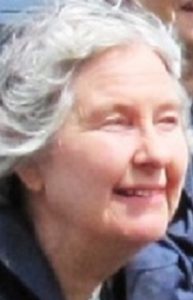
It was the summer of 1946. I was 10 years old and we had taken shelter from the wind and rain in a little beach café on Dawlish Warren. At another table were some people who were not talking in the usual way but communicating with gestures and signs. I turned to my mother who explained they were deaf. That was my first encounter the deaf and deafness, something that was to remain with me for my entire life though I did not know it then.
… In November 1944 my only sister was born, the youngest of five children. In 1946 sitting, crawling and walking were all delayed but there was no suspicion of a hearing loss at that time … Only gradually was the possibility of deafness mooted. She was found to be profoundly deaf.
… I left school and went to Bedford College for Women, London University, where I read History. Afterwards, instead of doing a PGCE I decided to train to be a Teacher of the Deaf at Manchester University. I shall never forget the comment of one of my former teachers, “what does a clever girl like you want to do that for? After all the deaf only need to sit at the front of the class.” The OL56, the first transistor hearing aids had just come into existence and were seen by many lay people as a cure-all. These sturdy body worn hearing aids replaced the heavy cumbersome aids with batteries in leather cases, which were difficult for my sister to carry around.
I was interviewed by Professor Alexander Ewing in a hotel off Oxford Street, London and offered a place at the Department of Education of the Deaf. I remember he stressed the importance of oralism. It was the age of “New Opportunities for Deaf Children.” I knew, however, that the adult deaf and many deaf children signed outside the classroom to communicate with one another. My sister had taught me signs and told me the names of many of her friends. In spite of the increased opportunities with transistor hearing aids for some children, the teaching of speech by teaching how specific sounds are physically produced rather than making the most of residual hearing was an important part of the curriculum.
As well as short visits to schools and partially hearing units, I spent two weeks in a secondary moderns in a poor area of Salford, a real eye-opener in many ways. The whole of the Spring Term was spent on teaching practice, the first half at Mary Hare Grammar School, the second half at Preston School for the Deaf, two very contrasting placements. At Mary Hare one of the staff slipped on ice, broke her arm and I took her classes for several weeks, an interesting experience. Quite a number of the staff at Mary Hare were not qualified Teachers of the Deaf or were currently undergoing in-service training. They had the cream of deaf children and/or children successful orally. Yet, they were very critical. Whilst at Mary Hare I was invited to sit in on a discussion about candidates for selection and was amazed at the prejudice against children from a school where it was thought signing was predominant outside of the classroom, namely Margate. I recognised the names of some of the children! None of them was offered a place.
The other half of the term was very different in Preston. There I was very much “the student”. The teacher split the class in two. I had one half of the room and she had the other. There was an invisible barrier between us.
On completing the course, I was offered a place doing research in the Department, but I wanted to get out into the world of work and Manchester in the 1950s was a smoky foggy city. I obtained a job at Nutfield Priory School in Surrey under Sam and Joy Blount, and Norah Browning was Deputy Head. There was a sort of affinity between us. We all had personal connections with the deaf. All three had previously been at Margate. Sam Blount was full of enthusiasm for his “new” school, for the possibilities of a greater oral emphasis. He brought with him “diagrammatical English” from Mr Swayne at Margate, a system, which helped to overcome problems with sentence structure. He managed to introduce CSE exams for his pupils, obtaining permission to create a syllabus appropriate for the deaf. Every night the children came into the hall to watch the television news. The teacher on duty had to give a spontaneous commentary to what was said. There were no subtitles for the deaf then. Once I remember there was a power cut and it was extremely difficult holding a large lantern so my lips could be seen and at the same time giving a commentary.
Plus points were given to encourage oralism and minus points for too much signing. Hearing aids were valuable items so were not necessarily worn outside the classroom in many schools for the deaf. Commercial hearing aids were just coming in and a group of children in my class living in the same local authority were issued with identical hearing aids and probably with identical settings too. The understanding of audiology and differences in hearing loss was still in its infancy. Integration in the local community was encouraged and I took a group of Nutfield Priory children to the local Guide Company and ended up running it! On Saturday mornings we walked into Redhill to the Pictures and back again in time for lunch. On Sunday afternoons we took the children for a walk. If there were under 20 children only one member of staff was required. I may have the number wrong but I do know that nowadays the number of any children, let alone deaf ones is far, far lower!
After Nutfield I went to Heston School, close to Heathrow airport. When in the dining hall it sounded as though planes were coming through the roof! Only one room was sound-proofed. The school day was shorter because of the children arriving and departing in a fleet of taxis. There was less opportunity for incidental learning. On the other hand, some of the children were able to join sports clubs or play with hearing children in the neighbourhood and had the benefit of home.
Looking back at the formation of the Association in 1976, it is staggering to think that anyone involved in that formation would have predicted all the changes that might occur. Almost at the same time as BATOD was formed the government convened the Warnock Committee which produced a groundbreaking report and suggestions for new ways of dealing with children’s Special Educational Needs. The resulting legislation and subsequent education acts produced changes that have affected all teachers in all schools. However, the purpose of this article is not intended to be a catalogue of all these changes, nor is its purpose purely historical, rather it is hoped that what follows will be an appreciation of our Association –The British Association of Teachers of the Deaf.
I imagine that there are few current members of our profession who were there at the formation of the Association in 1976. Most, like the writer, will have retired and not many will be able to recall the sense of excitement, enthusiasm and hope which pervaded that time.
Professional organisations for Teachers of the Deaf have a long and venerable history.
The College of Teachers of the Deaf and Dumb (established in 1885) and the National Association of Teachers of the Deaf and Dumb (established 1895) amalgamated to form NCTD (1918). The College brought to this union the right to examine. The Association brought organisation, branch membership, a journal and teacher training. The new organisation became therefore a substantial body and a force to be reckoned with.
It was due to dissatisfaction with the standards of teaching and conditions in the big residential schools in the late 19th century that the Ealing College and Fitzroy Square Association for the training of teachers in the oral methods came into being. In time this led to the inauguration of the National College of Teachers of the Deaf in 1918. The following year Manchester University opened the precursor to what is now the Centre for Human Communication and Deafness (CHCD). The need then, as now, was for an adequate supply of effective teachers. It is with some pride that our profession can claim to have been at the forefront in teacher training by giving it high priority. We were also one of the few sections of teaching that was able to examine and thereby control entry into this sector of the teaching profession.
If one ignores the independent sector, which of course is very old, the teaching profession in this country was developed from the 1870 Elementary Education Act which set up the School Boards. This act influenced our profession too, as did the later Blind and Deaf Children’s Act (1893) but through our ‘College’ we were able to establish a link between training and schools which has been one of our strengths.
The National College of Teachers of the Deaf and the Department at Manchester dominated deaf education for the best part of half a century. It was not until the 1950s that the winds of change started to blow, which culminated in the formation of our association in 1976.
The 1950s and 1960s were (as ever) times of change in education. There was a chronic shortage of teachers. There were ‘bulges’ going through the schools and more children meant more deaf children. Deafness was not more common, it just meant that the ratio stayed much the same. There was therefore a pressure to find more Teachers of the Deaf. In addition, diagnosis was improving in both medical and educational terms and, although there were still casualties of late diagnosis and wrong placement, it all meant more work for Teachers of the Deaf. Added to this, more LEAs were opening Partially Hearing Units and starting Peripatetic Services. Units had been in existence before World War II but they really took off from the 1950s onwards. It was against this background that the Society of Teachers of the Deaf (STD) came into existence in 1959.
Teachers working in new positions in hospitals, as peripatetic teachers and in units, formed the STD. This was received with some regret by the NCTD who viewed a united profession as essential. The College was quite correct in this but really only had itself to blame for what became at times a rancorous split. It was slow to change and even slower to recognise the needs and special problems of those working in the ‘external’ services. The College was dominated by the heads of the special schools, especially the residential schools, as a glance at the make-up of the NCTD executive in those far-off days will amply illustrate. The issues were naturally muddied by the ever-present oral/manual controversy but this was less of an issue than some made it out to be.
The process which led to the eventual union in 1976 was long. There were many meetings and many discussions but finally the driving force came from the two leaders, Mr JRW French, MBE, Chairman of the NCTD and Mr Derek Wilton-Brown, his opposite number on the STD in the years immediately before the union. There were various attempts to unite between 1959 and 1974 but all had foundered for a variety of reasons.
The College suggested that the Society should become a branch of itself but this was rejected because the STD believed that it had an important rôle to play in the education of teachers involved and working other than in special schools. The neglect of this aspect of our work had been the very reason for the original split! Another stumbling block was the different methods of election between the two organisations. The NCTD had a non-specific election to its executive. This was fine on paper but in practice led to an over-representation of the special schools by their headteachers (see above). The STD specified representation from clinics, hospitals, Partially Hearing Units (PHUs) and peripatetic teachers.
By 1974 it was becoming ever clearer that our profession was doing itself absolutely no good by its continued division. The NCTD chairman stated, “It seems to me to be suicidal that as a profession we should face the oncoming situation with two organisations representing some 1200 teachers…the advantages of professional solidarity, harmony amongst teachers working in and out of schools and rationalisation and extension of teaching facilities for teachers are in my view overwhelming.” The changes in medical and educational practice, the reorganisation of local government and the NHS and perhaps above all the need for the profession to have a united voice in the teachers’ salary negotiations were all pressing reasons for a single organisation.
Finally, it was agreed that both Associations should dissolve and a new one be formed. This was easier for the STD than for NCTD because the latter had special monies such as the Mary Grace Wilkins Scholarship, the Braidwood Medal fund and so on, in addition to its special examining function. However, these problems were resolved by much hard work. The inaugural meeting of BATOD was held in October 1976 in Birmingham. The first President was Conrad Powell.
The question that arises is whether or not the new association obtained the best from each of the old organisations. This writer believes that it did. The categories of representation to the National Executive prevented any section of the profession becoming too influential (this came from the STD). More recent change to encourage ToDs to focus on specific areas of interest has provided the opportunity for a range of skills to be represented on the NEC. The development of regions has allowed for local representation and activity (this came from the NCTD whose branches were always its strength).
The teacher training element has changed out of all recognition since 1976. The most popular method of training was by secondment to a full-time post-experience course, end-on from University or teacher training, or by in-service through the NCTD.
How different things are today! BATOD no longer has its ‘Exam Board’ providing the in-service training and examination route to becoming a ToD. Instead the Association is represented at Course Provider meetings and negotiates with the TTA. Now there are six universities in the UK providing ToD training, with a possibility of a seventh.
Since its inauguration, BATOD has had to respond to many government initiatives and other pressures. The Warnock committee and the ensuing legislation have already been mentioned. The pressure for ever more integration has increased from year to year and BATOD has had to respond to this.
Nowadays deaf people are being encouraged to teach deaf children, which was virtually unthinkable when the writer trained at Manchester in 1963/4. BATOD has accommodated this change too through close liaison with the National Deaf Children’s Society (NDCS), so that deaf people wishing to train as ToDs are provided with the most comprehensive and helpful information available.
Recently we have seen the development of different approaches to the education of children with a variety of special educational needs. This has sometimes led to educating children with differing special needs together. BATOD has responded well to all of this. For example, we have maintained good relations with other bodies working in special education, whilst at the same time maintaining the distinctiveness of our own specialism.
Representation has been made to all kinds of committees and organisations. Reference has already been made to the Warnock Committee and the results of its deliberations but the Association has pursued a consistent policy for the retention of our specialist qualification by representation to bodies such as the Advisory Committee on the supply and training of teachers. BATOD has continued to respond to a range of consultation documents.
What will the next 25 years bring? Is it possible that in 25 years time there will be no schools at all? Such a suggestion might seem to be rather eccentric but is it? Advances in Information Technology certainly makes exclusive home learning for all ages possible but probably unlikely. Social skills would be almost impossible to learn, even from ‘virtual reality’. The trend for more deaf children to be educated in their local schools is certain to continue and who can foresee what further advances there will be in hearing aid technology and medical treatment?
If BATOD maintains its present course, it will do more than cope, indeed it will make, as it always has done, a major contribution to any debate. One of the most effective ways of doing this is through the internationally respected Journal, Deafness and Education International and the imaginatively produced Association Magazine. In the writer’s opinion, those members of the profession who do not belong to the Association are missing out. BATOD may not be a Union but it is of great value to belong to an organisation that has its finger on the pulse of education of deaf children and young people, which can offer advice and make direct representation to government and other bodies.
In the magazine of May 2000, the NEC pointed out that proposals in the SEN and Disability Rights in Education Bill will focus on the right of a child to a mainstream placement regardless of that child’s educational needs unless the parents wish otherwise. There will be problems stemming from that if the Bill becomes an Act! None of this should deter BATOD from battling on. No one could have put it better than the first President, Conrad Powell, who in his inaugural address in 1976 said, “There are many problems that confront us, some so difficult that one wonders where the solutions lie, or even if they can be resolved. But the fact that a problem seems to be insoluble is no reason why we should not attempt to find the answer – quite the reverse, we should double our efforts.”

Why deaf education? I’d always wanted to be a teacher and from the age of thirteen I wanted to be a Teacher of the Deaf, not really understanding at that time what this meant. I had a friend who had a deaf brother who used British Sign Language (BSL). He was the one stood in the corner with no one being able to communicate with him. I was really interested in watching how he and his sister communicated and knew that I wanted to know more.
I completed a Certificate in Education at Bretton Hall and then went onto Maria Grey College to do a Certificate in Teaching Deaf and Partially Hearing Children. Later, as well as a BEd. Hons and MSc in Educational Leadership, I also obtained an Advanced Diploma in Total Communication at the University of Leeds. I commenced my Teacher of the Deaf (ToD) course knowing the theories about teaching hearing children but having very little practical experience as I undertook the course as a “bolt on” after my teacher training course. My knowledge of deafness was limited to my friend’s brother, a visit to Manchester School for the Deaf during its oral days and a bit of reading from books I found in the local library – no internet in those days.
The Maria Grey ToD course was, I know now, forward thinking for its time (1978-1979) and helped me a great deal to not only learn about deaf education but also to reflect on the oral vs. manual debate, something that has continued (using different terminology) throughout my career.
I wish that in the early days I had had the knowledge and skills I have now. My first teaching job was in Sheffield with two deafblind children with severe learning difficulties using Paget Gorman to communicate. This was in the days when the Warnock report was just starting to make an impact on SEN education and with no national curriculum. We all had fun, and I’m sure the children learnt something but I’m glad the Ofsted inspector who visited didn’t know anything about teaching deafblind children. However, supported by a peripatetic ToD from the area I learnt a great deal about deaf education and teaching children with special educational needs. During this time I was learning BSL and also started to visit Wakefield Deaf Club. My Deaf friends at Wakefield taught me a great deal about deafness. I was also asked to run some adult learning classes in liaison with Wakefield College which helped me to understand better how deaf people learn.
Doing the Advanced Diploma in Total Communication at the University of Leeds further increased my knowledge of deaf education and helped me to reflect on the ongoing debates, especially regarding communication issues. It was during this course that I met Miranda Pickersgill and Ruth Swanwick who were part of a group called Language of Sign as an Educational Resource (LASER). I became interested in their thinking and debates. Some of the people who were in this group I still know now as members of the Sign Bilingual Consortium.
In 1989 I moved to Wakefield Council (for the first time) to work as an advisory Teacher of the Deaf. This was challenging at times, as communication policies in Wakefield were then dominated by spoken English whilst I could see how the use of sign could have supported children in their learning. When I returned in 2002, now as the lead for the Deaf and HI Service, Wakefield had two primary resource bases and was able to offer more of a continuum of support. I was pleased that during my time there I was involved in opening a secondary resource and in amalgamating the two primary resource bases with a focus on language development in English and BSL supported by Deaf and hearing colleagues.
In the late 80s the service also carried out support at the further education college. I became interested in the skills deaf young people had to access this hearing environment and their social and emotional wellbeing; another theme that has followed me throughout my career
I had more opportunity to explore this further when the college became independent from the Local Education Authority and I eventually moved to work full time at Wakefield College within the Additional Support Team. I ended up as their Additional Support Manager, managing additional support for students with any disability and delivering, with my Deaf colleague, a 7307 Teacher Training for Post-16 for Deaf students, the development of training for support workers as well as managing Deaf Studies and BSL training.
The development of these courses and support for deaf students was not easy to develop. It took a great deal of time to convince other people that Deaf students benefited from learning in their first language and that there was still a way to go educating hearing people about deafness.
In 2000 I was approached by the University of Leeds (for the first time) asking if I would be interested in being a regional tutor for the MA in Deaf Education.
In 2006 I found myself moving to Cornwall and working in Plymouth as manager of the Sensory Support Service. A long way from Yorkshire but with just the same challenges within deaf education. Plymouth LA was open to new ideas and somehow I became involved in developing a deaf charter, based on the BDA Deaf Charter and Devon’s charter, which included a pledge for education in the city to offer a bi-lingual (BSL and English) approach.
2012 saw my return back ‘up north’ and to another local authority, this time York. Once a very oral authority now successfully supporting BSL first language users in their local school. I left York at the start of this year to “retire”, leaving behind two recently opened central provisions run by the specialist teaching team and on-going discussions within the deaf and hearing support team about language development and how to get the support right.
That’s a very quick 37 years that saw many changes, including:
- Deaf adults being involved in educating deaf children.
- ToD students working at Master’s level.
- More research about how deaf children learn.
- Great changes in technology.
- More debates about language use.
- BSL recognised as a language in its own right. (2003)
- Better access to further and higher education for deaf learners. Disabled Students Allowance (1993).
- Social and emotional wellbeing is now high on the government’s agenda.
I said I left York to retire; well, that was the idea, but I guess once a ToD always a ToD and I continue to keep my hand in working as a Regional Tutor and Teaching Practice Co-ordinator for the University of Leeds and supervising ToD students for the University of Manchester.
I am really enjoying using my experience, learning new things and being part of training new Teachers of the Deaf. I often wish I was 21 again, knowing what I know now, but then I wouldn’t have all the experience I have gained over the years or met all the deaf children, adults and their families or the passionate people who work with deaf children and adults who helped me develop my thinking and career.
Lester is now retired and was previously a Teacher of the Deaf and Headmaster of Hawkswood School
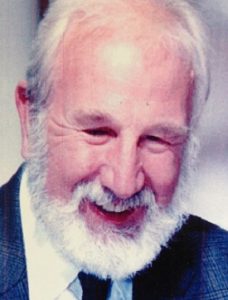
After approximately three years teaching in a secondary school I happened to see a TV documentary about PHUs (Partially Hearing Units). Consequently, in 1959 I applied for and got a year’s secondment to Manchester University to train and qualify as a Teacher of the Deaf. Professor Ewing was responsible for leading the course and his philosophy and conviction was strictly an oral/aural approach based on the use of hearing aids together with lip reading. Signing was considered inappropriate as it discouraged speech and limited communication with non-signers. The course I followed (1959-60) lasted for one academic year. I do not know how many students were on the course that year, possibly 60, and most were graduates with no experience of teaching. The only two lecturers whose names I remember are Mr John and Dr Watson. Mr John dealt with hearing aids and acoustics and Dr Watson was more directly involved in teaching.
I have no particular memories of lectures but I would have preferred more time to be given to the understanding of residual hearing use, limitations of hearing aids and the emotional difficulties hearing impairment may cause.
In 1960 most students were confident they would pass the written papers and qualify as a Teacher of the Deaf, even though many had no experience of teaching.
Teaching practices were arranged by the tutors, including one short initial practice in a mainstream school. All students had to do the practice but I think it was aimed primarily at graduates with no teaching experience.
My main teaching practice in a school for the deaf was at the Jewish school for the deaf in London. I think it was a four or five week practice requiring some teaching on a daily basis. Lessons had to be pre-planned and written into a log book. Each lesson required an aim or aims and a personal assessment of success or otherwise had to be added after the lesson had taken place. Tutors would also assess and add their criticisms on a weekly basis. This would form the guidance given for the practice.
In 1963/4 I was fortunate to be seconded for a second time to follow a diploma in Audiology at Manchester University led by Professor Taylor. This also took one academic year and was open to experienced Teachers of the Deaf, speech therapists and medical doctors. In my year I was one of four Teachers of the Deaf; there were also four speech therapists and one medical doctor.
The course was not primarily concerned with deaf education but was rather more technical and related to diagnosis, medical and functional aspects, acoustics, hearing aids. I enjoyed the course though I found Professor Taylor’s lectures rather demanding.
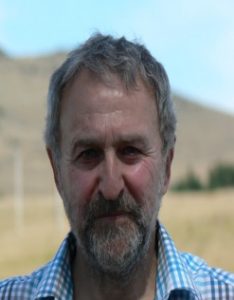
Principal of the Royal School for the Deaf, Derby from 1991-2005 and previously Head of Services for Deaf and Hearing Impaired Children in Derbyshire
My formal qualification to teach deaf children is: Dip NCTD, obtained in 1977. I may have been one of the last to obtain this qualification as NCTD, the National College of Teachers of the Deaf, merged with the Society of Teachers of the Deaf to form BATOD around that time.
At that time, I was working in a school for deaf children in the north of England, which has since closed. As for many serving teachers at that time, the possibility of a year’s full time secondment, the other usual route for qualification, was not very likely.
Since it is some 40 years ago, my memory of the details of that time may be a bit hazy. To be valid and recognised, the examination had to have the same rigour as the full time courses. The formal papers were: History of deaf education; language development; audiology; and one other. There were also practical assessments of classroom teaching and speech teaching. Aside from this, there were a number of essays or assignments that had to be submitted throughout the duration of the course.
I use the word ‘course’, but in many cases, this course was somewhat informal. The only formal taught sessions were a one week residential at Easter time followed by a weekend in the Autumn term to act as a revision opportunity for the exams that took place the spring term. The tutors were established senior figures from the practical world of the education of deaf children, such as head teachers and audiologists. The balance of teaching took place in your own school from various staff who were designated by the head to act as tutors. They talked mainly from their own experience of a topic, rather than a prepared theoretical lecture.
I sometimes refer to that time as a ‘missed’ year in terms of family life. I did not find it easy to study at the required level after a day’s teaching, so I went to bed early and studied in the early mornings. My main source of information was from textbooks, but there was no one on hand to answer queries or discuss further any points that emerged.
Speech teaching was problematic for me. There were no really appropriate role models in the school that seemed to be teaching in the way that we were going to be examined. We had to demonstrate that we could make the children articulate just about all of the speech sounds. I had one pupil who was able to do this, but he never used any of those sound in connected speech outside of these sessions – but he did help me to pass!
Did it help me become a better Teacher of the Deaf? Undoubtedly, there is a need to study and understand a sizeable body of specific information regarding communication, speech and language development and audiology, but in this theoretical area, I do not think I was best prepared.
A few years ago, I was a regional tutor on the Leeds course for training Teachers of the Deaf and the participants on that course have a much more in-depth experience of the theoretical aspects of what is needed to prepare you to undertake this role more successfully. I think I missed out on this aspect of training and the benefits of being with a group of other teachers who could share their experiences.
In 1972 I was in the final year of my degree course at Bristol University and I was undecided as to what to do next. Following my father’s suggestion, I visited the old Elmfield School in Bristol and this made a big impression on me. There was something both terrifying and fascinating about what I saw and heard from the children so I did apply for the course and was accepted. Interestingly I didn’t take in that it was about teaching; it was the ‘deaf’ part that attracted me. I didn’t see myself as a teacher although I had done some volunteer teaching to a Ugandan Indian family who had recently arrived in Bristol.
At that time the course in Manchester was one year full-time and qualified one to teach hearing as well as deaf children. I enjoyed the course. It was a neat package, pretty convincing and of course totally based on the medical model and oralism. But I didn’t question this at that stage and I found the information on language and child development particularly interesting. It was only on school visits and when I came to do my teaching practices that I began to have suspicions that all was not as I was being led to believe. But the Manchester staff were reassuring and made it clear that there would be no need for anything other than the techniques I was learning. Any reference to sign was dismissed and there was certainly no debate or discussion. I was taken in by the belief that one would be ‘saving’ the deaf children and there was a real feeling of a calling to this work which was reinforced by the presence of nuns and priests in many of the schools we visited! There was something attractive about the almost missionary zeal with which we were to be sent out into the world of deaf schools. Looking back, I can see that the training was about us as teachers and how we would need to perform; even on my teaching practices the assessors didn’t seem concerned about whether the children could understand me at all.
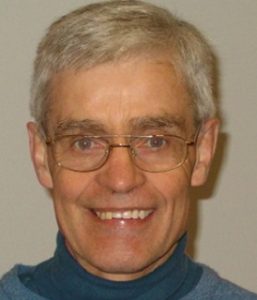
In the Journal of the National College of Teachers of the Deaf (NCTD) – December 1964 – it was reported that there was a shortage of Teachers of the Deaf (ToDs) due to the rapidly expanding peripatetic teaching services which were inevitably draining “teaching personnel from the established schools for the deaf.” In the same Journal there were advertisements for ToDs (for Special Schools, Units and Peripatetic Services) in Swindon, Leeds (2), Surrey, London (10), Birmingham, Hull, Newcastle (1+), Bolton and Kent (2). It seems therefore that there was a need to recruit more staff but also to supply appropriate training for those new to the profession. At the time there were only two courses being advertised in the Journal: the National College of Teachers of the Deaf Diploma and the University of Manchester Certificate for Teachers of the Deaf.
Some discussions had taken place, as reported in the NCTD Minutes of December 1964, regarding setting up a London based course. In the same month, the first advertisement was placed in the Journal:
University of London Institute of Education: Diploma in the Education of Deaf and Partially Hearing Children.
The above one year full time course is open to qualified teachers with substantial (i.e. not less than 5 years) teaching experience. Successful candidates will be eligible to apply for financial assistance as set out in the Programme of Courses for Qualified Teachers issued by the Department of Education and Science.
Having relinquished my teaching post in a grammar school to work in a primary school for the deaf, I did a year as an unqualified ToD and, despite having a steep learning curve and making many misjudgements, I applied for the London Course. I guess by today’s austerity measures, I was very lucky to engage in a full time course and get paid for it! It meant travelling up to London daily from Essex, where lectures took place in the basement of a Georgian/Victorian building.
The main tutors were Darcy Dale, Geoff Ivimey and Gwenda Watchman, but quite a number of other speakers came to talk about their involvement in deaf education, e.g. Freddy (Elfrieden) Bloom, Ken Pegg and Pat Keysell.
The lectures were very varied and helped enormously in increasing our knowledge.
The course content included: Audiology, Speech, Language, Social and Administrative Aspects – all of which were examined at the end of the year.
By 1975 there was a choice of options which one could select from the following six:
Audiology, Phonetics and Speech, Language, Curriculum Development and The Social Psychology of Handicap.
Some examples of the dreaded examination questions:
Social & Administration: “Describe the welfare services that exist to help the hearing handicapped.”
Language: “Discuss the use of conversation methods in language development.”
Speech: “Discuss the following statement: ‘An analytic method of speech teaching of itself, therefore violates basic physiological and phonetic principles.’ Hudgins & Numbers 1942.
In addition, we were required to undertake teaching practice in a variety of settings – again very helpful. I was able to spend time in the following schools:
Teaching Practice Junior Unit – Mildmay Primary School, Chelmsford
Secondary Residential – East Anglian School for the Deaf, Gorleston
Nursery Infant Unit, Rayleigh
Group Practice: Junior Unit, Meridian Primary School, London
The Group Practice involved teaching a class of deaf children in front of our designated tutor and a number of colleagues – intimidating stuff!
Visits to other schools were made such as to Larchmoor School for the Deaf at Stoke Poges which was an ‘all aged school for deaf and partially hearing children who ‘are emotionally disturbed’ and to St Michielsgestel in the Netherlands where the ‘Maternal Reflective Method’ of helping deaf children to acquire language evolved.
Overall it was an extremely worthwhile and interesting experience although we, of course moaned about this and that! Particular memories (polite ones) were:
- St Michielsgestel: the deaf children here were speaking better English than the deaf children in the UK!
- Travelling up to London on the Tube, getting a seat and swotting up what we had to learn.
- East Anglian School for the Deaf: At break time in the morning, everyone went to the staffroom for tea/coffee, but there were distinct cliques whereby the care staff formed one group and the teachers another. In the afternoon teachers went to the ‘appropriate’ staffroom – one for ladies and one for gentlemen.
- Beginning to understand how language was acquired and the implications for deaf children: plus of course the on-going arguments about manual and oral education.
End note
Ted adds the following note about developments in the London Programme after he left in 1973:
- 1974 Sept: London Diploma course advertised. The last advert?
- 1974 Sept: Diploma in Advanced Educational Studies (Education of the Deaf) advertised as a one year full time course.
- 1976 July: University of London Institute of Education advertised for the Diploma in the Advanced Study of the Education of Deaf Children. One year full time or two years part time. It came under the Department of Child Development and Educational Psychology .
- 1978 (Sept) Certificate in the Education of Deaf and Partially Handicapped (?!) Children – a full-time, 1 year course advertised not at the London Institute but at Borough Road College: Maria Grey College, Chiswick.
- 1979 March: A course was advertised in the BATOD journal: Advanced Certificate in the Education of Deaf and Partially Hearing Children – a full-time, 1 year course. Bristol Polytechnic
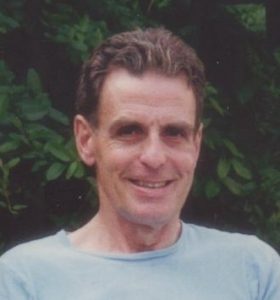 Tony Fennemore writes:
Tony Fennemore writes:
The Certificate Course for Teachers of the Deaf and Hearing-Impaired had its first intake of students in the academic year 1970-71. The course was validated by the University of Oxford Delegacy for Educational Studies and was based at the Lady Spencer Churchhill College of Education at Wheatley on the outskirts of Oxford.
Miss Norah North was the first course director, a former head teacher of the Braidwood School for the Deaf at Birmingham. Miss North had extensive experience in the training of Teachers of the Deaf via the Examination Board of the National College for Teachers of the Deaf.
At Oxford, Miss North was assisted by Mr John Wells, educational advisor for the Reading Education Authority. He was responsible for the teaching of audiology. Miss Johnson, HMI and former head of The Old Kent Road School for the Deaf, London, gave advice when needed and provided useful information about developments in the field of deaf education from her experience of observing patterns of good practice throughout England and on the continent. The medical aspects of the course were covered by lecturers from the ENT staff at the Radcliffe Infirmary who also granted the students the opportunity to observe surgical practices related to the improvement of hearing.
The Oxford course held a visiting week each year which enabled students to observe the outstanding work in the field. In particular, it provided the opportunity for students from Oxford to visit the School for the Deaf at St. Michielsgestel. During visits week, they also visited Birkdale School in Lancashire, the Woodford School in Essex, St Johns School Boston Spa, the Royal School for the Deaf Edgbaston, Doncaster School for the Deaf, Northern Counties School for the Deaf (where Total Communication was used) and the School at Cabra in Dublin.
Miss Johnson stressed the importance of attending to the need for a clear understanding of development basing her comments on the linguistic approach of successful schools such as Birkdale, Woodford, and St Michielsgestel in the Netherlands. Such institutions based practice on normal child language development rather than focusing on formal grammatical and vocabulary training. She emphasised the fact that the more effective schools stressed attention to prosodic features with the use of hearing aids, rather than an over emphasis on articulation teaching which tended to slow the rate of delivery down. Along with this, stress was placed on the role of dialogue in the development of language, using the term ‘maternal reflective’ as employed by Father van Uden at the school at St Michielsgestel. The advances in audiology provided tremendous help in making even better use of auditory equipment.
With the second intake of students, Miss North appointed me to assist her, and in our discussion on course philosophy she said it was like building a ship whilst continuing to sail in her. The next member of the tutorial staff to be appointed was Mr David Braybrook, a lively, imaginative and experienced Teacher of the Deaf and then Maryanne Tate. Maryanne was followed by Mrs Wendy Gardiner, one of the graduates of the course who had been teaching at the Mary Hare Grammar School and had proved to be an outstanding student.
Following health problems, Miss North retired and we were fortunate to attract Con Powell, an audiology lecturer from the University of Manchester as our new course leader. He and David Braybrook set to work to make a series of videos recording language usage by deaf children, which they put together to provide a demonstration video. This was shown at the National College of Teachers of the Deaf “100 years after Milan” conference where it created great interest. “100 Years After Milan” was a powerful trigger leading, amongst other things, to the foundation of NAG/DELTA. Many people were involved in the early days of NAG’s development, but Con Powell and David Braybrook were instrumental in making things happen and eventually around 20 Founder Members each put £5 into a pot to enable the new organisation to get off the ground. They included David Harrison (Leicestershire) Morag Clarke (Birkdale) and Sister Barbara Walsh (St John’s Boston Spa). This was a foundation of the National Aural Group, a pioneering group formed to assist parents as well as teachers in the development of communication skills.
Additional staff now joined the course: Sue Lewis and then Elizabeth Andrews another outstanding past student of the course. Con Powell was promoted within the college as Head of Educational Development and I became course leader. David Braybrook became Head of Ovingdean School, Brighton where he was able to put his ideas of good educational practice into action.
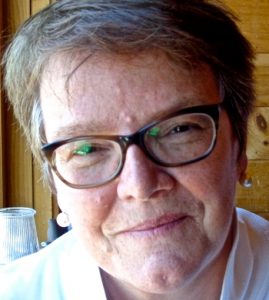
Elizabeth Andrews writes:
Teacher training for Teachers of the Deaf at Oxford from September 1977
Snapshot: The Oxford Polytechnic Course in the academic year 1977-1978
The Certificate in Education (Teaching Hearing-Impaired Children) (CETHIC) was a one-year, full-time residential training course based at Oxford Polytechnic. The cohort size for the course in 1977-1978 was 45 students, typical for the time. The group was made up of 50% experienced teachers re-training in the specialist field of the education of deaf children and 50% newly-qualified teachers, known as ‘end on students’. Participating teachers were seconded onto the course by their employing school or Local Educational Authority (LEA). ‘End on students’ came to the course having completed a BEd or PGCE and were supported by grants awarded to them as individuals by their LEA. There were very few, if any, privately funded students.
Successful completion of the course and qualification as a Teacher of the Deaf entitled students to work with deaf children, aged 0-16, in any setting. However, received wisdom at the time was that following qualification as a Teacher of the Deaf, teachers should only move into a peripatetic role after consolidating their practical experience of working with children in units for hearing-impaired children or in special schools.
In the late 1970s, both theoretical and practical components of the course were delivered face-to-face by four full-time, dedicated members of staff, all of whom were experienced teachers of deaf children and young people. Two members of staff also held qualifications as audiologists. The course team in 1977/1978 comprised: Con Powell (Course Leader), Tony Fennemore, David Braybrook (later left Oxford to become Head of Ovingdean Hall School) and Maryanne Tate.
Students also had access to a wide range of other speakers and views, particularly during themed periods of input such as the Introductory Week and ‘Methods’ Week.
Staff information after 1978
Sue Lewis, an experienced Teacher of the Deaf with a particular interest in developmental linguistics, was appointed to replace Wendy Gardner (in 1980/81). Elizabeth Andrews joined the team as a lecturer in 1994 direct from classroom practice at St. John’s, School Boston Spa and following three months on an international course at the Instituut voor Doven, Sint Michielsgestel. She replaced Sue Lewis, who returned to work as a peripatetic Teacher of the Deaf in Shropshire.
Tony Fennemore took over as Course Leader when Con Powell was appointed as Head of Educational Development within the School of Education in 1994, but Con continued to deliver the Audiology elements on the course from that time. Elizabeth Andrews took over as Course Leader from September 1989, when Tony Fennemore retired. Nerys Roberts joined the team from January 1990. Nerys was an experienced peripatetic Teacher of the Deaf, working in Cheshire, who was additionally qualified as an Educational Audiologist.
Physical setting and training facilities: The Marjorie Linstead Centre
The course was housed in the Marjorie Linstead Centre, a purpose-built unit in the grounds of the Lady Spencer Churchill College. The Centre had the space and facilities to train up to 50 students at a time. Lady Spencer Churchill College had developed out of Bletchley Park College, a teacher training college that moved to a new, purpose-built site in Wheatley in the late 1960s. When Lady Spencer Churchill College merged with Oxford Polytechnic in 1976 the college became the Wheatley Campus and School of Education for the Polytechnic.
The Marjorie Linstead Centre was made up of two large spaces, divided by a one-way mirror and a dedicated Audiology Room, in which students were encouraged to practise using equipment outside of formal teaching sessions. One side of the Centre was used as a lecture room and the other was set up as a classroom, so that children could visit and be observed. There were also three rooms for members of staff in which 1:1 or small group tutorials took place. In the 1980s, when the size of the teaching team decreased, one of the staff rooms was used regularly as a base for Ewing Foundation peripatetic advisors. Faval Watton was based in the Centre from about 1985 and was succeeded by Linda Watson, from September 1990.
Course content in the 1970s and 1980s
The Oxford course drew on the latest research and, like other mandatory training courses, encouraged high aspiration for deaf children. The course placed heavy emphasis on the practical application of theory and competent classroom practice, including the ability to:
- build productive teaching and learning relationships with deaf children and maintain classroom control
- analyse language comprehension and expression in detail (including the accurate phonetic transcription of spoken language)
- develop effective teaching strategies
- make confident and optimal use of audiological equipment to support the development of children and their language.
Students were required to complete 2 x 6 week assessed periods of teaching practice in contrasting settings, both of which were supervised by members of the teaching staff. In addition, deaf children from local schools visited the Marjorie Linstead Centre, where students had the opportunity to observe demonstration lessons through the one-way mirror and, later, to work with children themselves while being videotaped, so that interaction and teaching could be analysed (micro-teaching). There was a practical test of audiological competence, which assessed the ability to take an audiogram, and to handle, monitor and maintain equipment used in classrooms – hearing aids, radio aids and group hearing aid systems.
Members of the course team took to the road for six weeks to supervise placements across England during periods of teaching practice. Students were therefore normally supervised by people they already had a relationship with and who already knew about their performance on other elements of the course. Failure to complete the course usually resulted from concern about a student’s performance with pupils in the classroom.
Given the historic association of the course with auditory-oral practice, it is important to note that the course opened each year with a week of lectures from visiting speakers representing a wide range of views about the education of deaf children. In the third term a ‘Methods Week’ also introduced students to speakers advocating many different communication approaches: Signed English, Sign Supported English (SSE), Cued Speech and Bilingual approaches in addition to Natural Aural and other auditory-oral approaches. All students participated in a one week, full immersion introduction to Sign Language (which later became an introduction to British Sign Language) in the Marjorie Linstead Centre as part of the course and were introduced to, and encouraged to attend the local Deaf Club in Oxford.
As mentioned in Tony Fennermore’s piece ‘Visits Week’ in Term 2 (usually February), was a distinctive feature of the Oxford training course in the 1970s and 1980s. The aim of the week was to give CETHIC students the opportunity to observe classroom practice of different types in action in schools and to stimulate discussion and reflection. Some students visited Sint Michielsgestel in the Netherlands and observed a range of practice with profoundly deaf children, based on Van Uden’s ‘differential diagnosis’ of dyspraxia and other conditions. Other students visited other schools in the UK, as already described by Tony.
- an oral Maternal Reflective approach in different departments of the main school
- Finger Spelling and a Graphic Oral approach at Eikenheuval, for profoundly deaf children and young people with identified dyspraxia
- sign language and Total Communication in use with deaf pupils with significant learning difficulties in the Mariella Pavillion.
Another distinctive and key element of training at Oxford was completion of a Language Study, which required students to tape, transcribe and analyse the emerging comprehension and expressive language of a hearing child between the age of 18 months and 2 years. The Language Study was a major piece of work which encouraged students to put everything they learnt about developmental linguistics and the analysis of syntax, phonology and interaction into practice.
Accreditation arrangements
The course was at first accredited by the University of Oxford Delegacy for Educational Studies. From the time Lady Spencer Churchill College became part of Oxford Polytechnic in 1976, the course became the subject of periodic (5 yearly) review and accreditation by the Council for National Academic Awards (CNAA). Two External Examiners reviewed a sample of all assessed elements of the course including teaching practice and interviewed a representative sample of students at the end of the course. The original certificate course was not modular, but thematic in design. CETHIC was eventually re-cast and re-validated as a modular Postgraduate Diploma (Teaching Hearing-Impaired Children) in 1990.
The influence of the Oxford course: 100 Years After Milan
In 1980 Con Powell and David Braybrook made ‘A Hundred Years After Milan’ an influential film of many conversations with profoundly deaf children and young people. All the children featured on the film had an average pre-lingual hearing loss greater than 90db, but spoke intelligibly. The film was made as a direct response to statements published by Conrad in ‘The Deaf School Child’ (1979) and the showing of the film at a series of national conferences (including BATOD conferences) had significant impact. It was also the catalyst leading to the foundation of a new organisation – the National Aural Group (NAG), which later became DELTA (Deaf Education Through Listening and Talking). NAG had 20 Founding Members.
The influence of the Oxford course: international links and development
During the late 1970s and 1980s, Con Powell, Sue Lewis and Elizabeth Andrews were all involved in development work overseas, particularly in India. Some of the development work done by Con Powell and Sue Lewis in Calcutta (now Kolkata) and Madras (now Chennai) was done with Ivan Tucker and Mike Nolan (then still based at the University of Manchester). Elizabeth Andrews was later and quite separately contracted to work with colleagues from the Netherlands to support developments in Southern India.
The move to the University of Birmingham
In the mid to late80s, ‘end on’ training came to an end and funding arrangements for seconded teachers changed dramatically, with LEATGs being replaced by a system of Grants for Education Support and Training (GEST). From this time onwards CETHIC, in common with all mandatory training courses for Teachers of the Deaf, experienced increasing difficulty attracting viable numbers of full-time students, despite the acknowledged high quality of the course. After much discussion and deliberation, it was therefore decided to close the CETHIC course down in 1992 and move the course team to the University of Birmingham, where training for Teachers of the Deaf had already been developed in distance-learning mode. An alternative might have been to develop distance-learning materials at Oxford, but the consensus at the time was that it was better not to go into competition with Birmingham, but to pool resources and develop a single, combined centre for training, which might be strong enough to survive longer term.
The final CETHIC students were therefore the 1992/1993 cohort, with Elizabeth Andrews and Nerys Roberts joining Brian Fraser and Steve Powers as lecturers at the University of Birmingham from September 1993. Oxford Polytechnic sold off the audiology equipment and library stock and used the teaching space in the Marjorie Linstead Centre for other purposes.
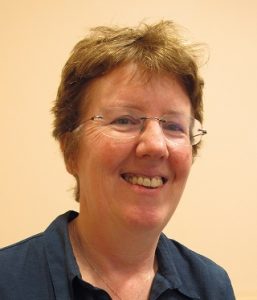
Training teachers of deaf children in Scotland started at the Moray House College of Education from 1970 when the Scottish Centre for Education of the Deaf was established (Kirk, 1985). This meant that Scottish teachers wanting to work with deaf children spent a year in Edinburgh rather than moving to Manchester for a year.
Cathie Finestone, now head of service for Falkirk Council, remembers studying at Moray House in the mid 1970s:
It was a full time course for a year with three teaching placements in the second term. At that point there were 20 teachers a year, and a similar number of overseas students. The tutors were Morag Turner, Tom McLaren and Kay Wassell. Miss Green and Ms Anthony in the Speech and Language department were super as was Mr Spears who taught audiology. (CF / RON: personal communication, 9.5.16)
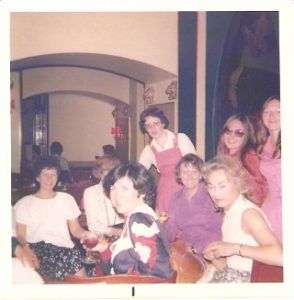
Helen Mitchell was also in the same 1975-6 year group:
The Audiology segment of the course was a two-hour lecture on a Friday afternoon delivered by a member of the Physics Department. We learned a lot about the physics of sound but had scant input on the range and properties of Hearing Aids. I was fortunate in having a friend who was an experienced Head of Service and who was willing to share her extensive knowledge of practical audiology with me. Many of my fellow students were not so fortunate. (Interview HM/RON: 2.7.12)
Mary Brennan came to the English department at Moray House in 1974 and started to investigate deaf children’s language acquisition in schools for the deaf. Her hard hitting 1975 article ‘Can deaf children acquire language?’ had important implications for the way deaf children were taught in the UK. The article was reprinted as a pamphlet supplement to the British Deaf Association magazine in 1976.
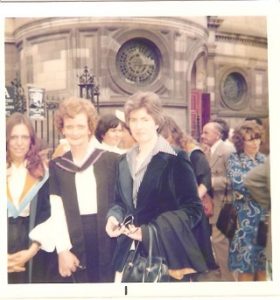
Cathie Finestone (left), Morag Turner and Mary Brennan
A visiting headteacher from Southport School, Morag Clark, delivering a talk to the student group commented, as reported by Helen Mitchell: Mary, I agree with you up to the staples (HM/RON: 2.7.12)
The first half of the article was a critique of the uncommunicative teaching methods teachers of deaf children often used at the time, correcting grammar rather than constructing meaning together in conversation. Examples from van Uden and the Ewings’ work made the article particularly shocking for the profession. It is significant that Morag Clark agreed with Mary’s analysis, though she did not agree with the solution, put forward in the second half of the article, for a bilingual approach using sign language.
Martin Colville joined the team in 1975. A social worker from a deaf family, his task was to introduce teachers of deaf children across Scotland to ‘manual communication’, including the teachers on the Moray House course.
He stood there, our first lesson was finger spelling … And he literally said to us, ‘my hand is the blackboard. My finger is the chalk!’ But he was trying to make it accurate and clear. And that’s how we tried to teach the children. (HM/RON: 2.7.12)
Martin and Mary started to collaborate, which led to the founding of the Edinburgh BSL project, the first time that the grammar of British Sign Language had been described and analysed and all its features presented in the publication ‘Words in Hand’. Mary worked with many deaf volunteers and paid researchers, including Lilian Lawson and Gerry Hughes. But the relationship with the staff of the course for Teachers of the Deaf was not always easy.
We can see the impact of the research in BSL in an advertisement to recruit a lecturer to the course at Moray House from 1986. Signed English was being advocated strongly by the national deaf school, Donaldson’s. The positivity about recruiting a deaf lecturer was unusual for this period:
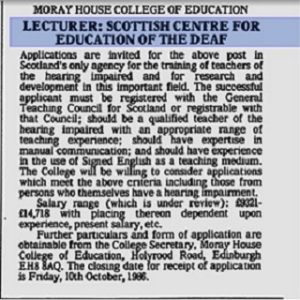
It would have been about 1992/3 when it went part time. We had a couple of meetings with unions etc. to discuss the implications for trainees but they said they had to align the course with the university courses so we couldn’t do anything about it. (CF / RON: 9.5.16)
At this point Moray House had amalgamated with Heriot Watt University. Some local authorities started to send their teachers on the Birmingham Distance Learning Course because of the placement decision. During this period, on the retiral of Ruth Macaree, Helen Mitchell became the sole full-time tutor on the Moray House course, and she also worked for the Scottish Sensory Centre, based at Moray House and established by the Government to provide ongoing professional development for teachers of deaf children in Scotland. Through the SSC, the Forum for Heads of Service in Scotland was first established in 1992. There were 28 part-time students scattered across Scotland doing the diploma course, all needing tutorials and support, but numbers declined to only five.
During the period 1992 to 1998 negotiations began with the Scottish Exam Board to consider the introduction of the use of BSL in exams. Secondary Schools within Inverclyde and East and South Ayrshire Services for the Deaf were used in the pilot scheme. In 1997 a 4 module Certificate in Sign in Education was developed for qualified Teachers of the Deaf and delivered by the full-time lecturer plus invited Deaf tutors. The first group of 12 teachers from different Local Authorities successfully completed the course in 1998.
In 1998 the relationship with Heriot Watt University ended and Moray House amalgamated with the University of Edinburgh. Mary Brennan had been at Durham University, returning to Moray House to lead the course to train teachers of deaf children in 1999 bringing a significant portfolio of relevant research to the post. There was some opposition in Scotland to the idea of a person from outside the profession taking on this role; the resultant divisions took many years to heal.
Mary established the Achievements of Deaf Pupils in Scotland research project from 2000, involving practitioners in tracking the attainments of all Scottish deaf children on local authority caseloads, including mildly deaf pupils. Her work on the course was concerned with children’s rights to linguistic access, through both speech and sign. Mary continued to investigate bilingual settings, including the development of a Deaf Studies curriculum and with the Scottish exam board, SQA, pioneered the use of BSL in exams (Brennan, 2000).
I became the programme leader in 2006 after the sad death of Mary Brennan a year earlier.
With support from BATOD the placement was reinstated, and a team of part time tutors across Scotland supports and assesses students on internal and external placement visits: Mary Dowell, Eileen Burns, Margaret Kinsman and Brian Shannan. Brian, an educational audiologist, organises the audiology course and Audrey Cameron, a deaf science teacher, leads the Deaf Studies course.
There are currently 30 part-time students on the diploma, with four continuing to the MEd. International students infill into some courses in the programme, bringing the advantage of being able to discuss deaf education in international contexts. The Scottish policy and legislative context is quite distinct from the rest of the UK, particularly concerning children’s rights; teachers reflect on this context throughout the diploma. I am currently the programme director for the wider MSc in Inclusive Education, which has full and part time routes. (http://bit.ly/1Wl2dVv)
The Scottish heads of services forum meets each term at the SSC, allowing close liaison between the course and employers of the teachers who come on the programme. The establishment of a deaf teachers’ email group is encouraging more deaf colleagues into the profession. There is an active research culture in relation to deaf education at the University, producing work related to the BSL Glossary at the SSC (SSC, 2016), analysis of deaf children’s achievements (Hendar & O’Neill, 2016) and research into the educational implications of poor classroom acoustics.
The postgraduate diploma in deaf education is now clearly set at Master’s level, retaining features passed on by previous post-holders: a focus on rights to linguistic access, careful monitoring of spoken and sign language development in the early years, and close professional collaboration with mainstream class teachers.
References
Brennan, M. (1975) Can deaf children acquire language? American Annals of the Deaf. 120 (5) 463 – 79.
Brennan, M. (2000) Fair Assessments for Deaf Candidates, SQA. (http://www.sqa.org.uk/sqa/76657.html)
Hendar, O & O’Neill, R (2016) ‘Monitoring the Achievement of Deaf Pupils in Sweden and Scotland: Approaches and Outcomes’ Deafness and Education International, 18 (1) 47-56 10.1080/14643154.2016.1142045
Kirk, G. (1985) Moray House and Professional Education 1835 – 1985. Edinburgh: Scottish Academic Press
Scottish Sensory Centre (2016) British Sign Language Glossary of curriculum terms (http://www.ssc.education.ed.ac.uk/BSL/list.html)
Interviews with Helen Mitchell were conducted as part of a history of the Edinburgh BSL project.
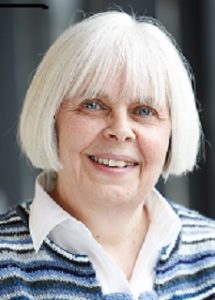
This Teacher of the Deaf course was set up in 1975 at what was then Hatfield Polytechnic, which became a University in 1992. It was part of the extensive provision for deaf children in Hertfordshire which included two special schools, Tewin Water (now Knightsfield) and Heathlands, together with units in primary schools and later provision in a secondary school. The course was led by Harry Kernohan and was for qualified and experienced teachers who were seconded for a year, full time, to attend the programme. A teacher who attended the course in the early days, Marion Storey, remembers the beautiful grounds and building, Wall Hall, near Radlett and course leader Harry Kernohan who was an inspirational tutor and Teacher of the Deaf. She valued the practical nature of the course and working with a group of over 20 like-minded teachers and felt that she left with a good understanding of deaf children and insight into their needs and how to meet these in the classroom. Following the course, she taught deaf children for over 30 years in Hertfordshire and London.
In the 1980s Joy Jarvis was a Teacher of the Deaf at the unit for deaf children in Stevenage and well remembers Harry bringing students into the classroom to demonstrate practice and enable students to take turns to undertake activities with the pupils. His facility in working with deaf pupils was amazing and the children (and teacher) enjoyed the visit and learnt a great deal. In 1993 Joy took over the leadership of the Teacher of the Deaf course. Initially it continued as a full-time course but gradually it became difficult for teachers to obtain full-time secondments so more students attended part time until it finally became a part-time course only. Teachers attended one day a week, plus two placements over 4 weeks each, over the course of two years. The aim was to develop understanding of the whole range of deafness, issues and strategies and the range of communication approaches.
In 2003 the course moved from the Wall Hall premises to a new building at the de Havilland campus of the University of Hertfordshire. Staff at the University worked with Teachers of the Deaf in the local schools and the advisory service who came to talk with students about particular aspects of their practice. Students visited a range of provisions in the area and in London and undertook placements here or further afield. The role of Teachers of the Deaf supporting the placements both as school mentors and as visiting supervisors was invaluable.
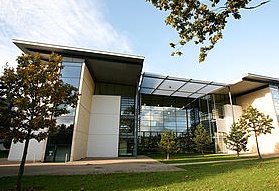
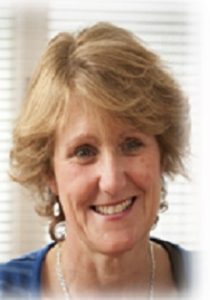
Ruth has been a lecturer/senior lecturer at Leeds University since 1992 when, together with Pam Knight, she developed the course for training Teachers of the Deaf. Prior to that she was a Teacher of the Deaf in the Leeds service for Deaf and Hearing-Impaired pupils.
When I started to run the deaf education (Teacher of the Deaf, ToD) programme at Leeds University in 1992 with Pam Knight, our training approach that encompassed a sign bilingual philosophy was distinctive. In the much politicised world of deaf education at that time this was a challenge on many fronts. Whilst firm in our conviction that this was the right way to conceptualise language issues in deaf education, it was impossible to please everyone and I remember feeling very keenly that a monolingual approach to the whole thing would have made life so much easier. Things that kept me awake at night in those early days of the programme days seemed so unresolvable: We wanted to grow our student Teacher of the Deaf numbers, but only accepting teachers with some pre-requisite sign language skills made it hard to recruit. This made the University unhappy. We wanted to offer sign language tuition at Leeds but because every single student had different skills and language learning needs, our BSL provision was criticised. We were urged to set high standards for BSL as part of the course requirements, but this meant that the risk of student failure was higher. As two hearing, albeit experienced, trainers the deaf community were sceptical of us and as trainers with a sign bilingual philosophy so was the hearing community! Everyone who advised us brought a political agenda that we just could not fully reconcile as a new and unusual enterprise within the Leeds HE context. As a result, I always felt guilty that I was somehow not doing justice to the sign bilingual cause and had sold out to University priorities and structures.
Things are different now. In deaf education we seem to have worked through many of these issues. Or at least, I can see where they belong in a training context: I notice and acknowledge them, but no longer let them lead. The shift to a more productive way of working, sans guilt, could be explained by changes in terms of context and perspective. Contextually, the use of sign language in education, and in society at large became less surprising. Research into sign linguistics grew as did public exposure to sign language in use and the availability of beginners’ courses in BSL: We rarely now have applications to the programme from teachers without any sign language skills or experience. The sign and spoken language polemic also seemed to soften. It is still very prevalent in the USA discourse around bilingual bicultural deaf education but in the UK we have become much more eclectic in approach and we have never driven a wedge between ‘deaf’ and ‘hard of hearing’ learners in terms of provision. The climate of deaf education seemed to change and as cochlear implants became increasingly prevalent the sign bilingual schools and services paused to critically reflect on their practice. As no stranger to self-examination, Leeds played a major role in this introspection and re-planning that has required thinking outside established language policies in deaf education.
In the 1980s and 1990s we limited our thinking about language and communication in deaf education by trying to carve out categorical language policies and define how we should, and should not, use languages in the classroom. There were reasons for doing that which were important at the time but those policies do not serve us now.
I still see a sign bilingual philosophy as the only approach to deaf education that is truly inclusive and open to bimodal and multilingual lives of deaf children where sign and spoken languages are not mutually exclusive. However, I have found over the years that it is just better to ‘live’ an approach rather than try to keep nailing it down in writing. The Leeds programme does not, and has never had, a ‘bilingual module’. Rather, a dynamic view of sign and spoken languages in use is embedded within everything that we do. The teachers that we work still sometimes come to Leeds hoping to get the short cut to sign bilingual ‘knowledge’. We disappoint them and go back to fundamentals: We ask them to ‘unthink’ the assumptions that they have come with.
What we help teachers to do at Leeds now is to step outside the language policy debate and look carefully, and without judgement, at the language repertoires that deaf learners bring to the classroom. We tell students on their first day with us to leave policy at the door and we point out that deaf pupils are not reading our language policies, they are doing what they can do with the language skills that they have. This frees up teachers to look again and to see much more, and there is so much more to see. The plural and diverse sign and spoken language skills that deaf children bring to the classroom are remarkable and hearing and communication technologies have never been so good. At Leeds now we are not paralysed by politics, we are too busy trying to keep up with what deaf learners are doing with language and prepare teachers to notice and to harness the dynamic multimodal and multilingual repertoires in play in their classrooms.
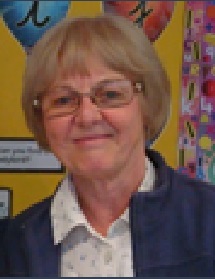
The 1960s heralded exciting developments in the education of deaf children. The audiology department at Manchester was in full swing. Professor Ewing, trained in psychology, was succeeded by Professor Ian Taylor, trained in medicine. Neither seemed to have a knowledge or skills in communicating with deaf adults whose first language was sign and both put all their faith in advances in audiology and the teaching of speech as the way forward for deaf education.
In the summer of 1968, in London, I was interviewed by Tom Watson for the Teacher of the Deaf course. My local authority, Hampshire, needed more trained Teachers of the Deaf and had generously offered me secondment to Manchester. The adviser for deaf education, Ben Pitchers, encouraged me to apply, having placed a deaf pupil in my class of 40 mainstream 10-11 year olds as there was no Teacher of the Deaf in the attached unit to the school; the pupil just survived!
Tom Watson had published his book The Education of the Hearing Impaired Child in 1967. At that time, deaf children were divided into two categories: deaf and partially hearing. Technical advances made during the Second World War had helped towards the development of the portable Medescro hearing aids, speech trainers and group aids. Assessment of hearing loss with audiometers was common practice and amplification, carefully prescribed for children, was considered the most important treatment for their communication needs.
I was fortunate to have accommodation in the old Ellis Llwyd Jones Hall, established along with the audiology department, named by the father after his deaf son, to house and train Teachers of the Deaf. At that time, the hall was all female and located in Talbot Road next to the demolished Royal School for the Deaf Manchester which had moved to new premises in Cheadle Hulme.
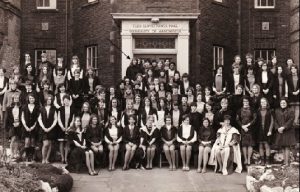
arrow identifying Sandra Dowe (1969)
The oral only method was not only strongly recommended, it was imposed on trainee Teachers of the Deaf. This meant that teaching and learning was slow, as we waited for the pupils to speech read, often losing the thread of information being imparted and struggling to express themselves orally.
The training we received in audiology and speech teaching was the best in the country, but there lacked expertise in communication with deaf pupils who obviously were not able to use an oral approach no matter what amplification was on offer. It was clearly demonstrated that a profound sensori-neural deafness could cause distortion when aids were worn but there was no alternative offered to the children but to communicate orally even though they could not receive nor produce clear speech.
Looking back on that year of training and the subsequent life time career in deaf education, I consider the Teachers of the Deaf course would have been more effective if deaf educationalists had been employed to teach us how to communicate with pupils using signing and fingerspelling and given us their views on the best ways for deaf children to learn.
I enjoyed my year at Manchester greatly but some of the pupils I taught on teaching practice placements would have enjoyed and benefited more from their classes if signing had been used so that they could express themselves easily and quickly in what, for most of them would be their first language.
Since then I believe there have been some advances in deaf communication at Manchester University and hopefully deaf children experience better communication with trainee students now in 2017.
History of the Department of Audiology and Deaf Education, University of Manchester - Dr Laura Dawes
In 2019, Manchester University’s audiology and deafness group will celebrate its centenary. To mark the occasion, the Ewing foundation has generously funded the preparation of a history of the department. The history will be available as a hard copy booklet and on Manchester university’s website. It is being researched and written by medical historian Laura Dawes.
The Scheme for the Training of Teachers of the Deaf, as it was called when it was first established, was set up in 1919 with funds donated by Manchester cotton magnate James Jones. Jones’ son, Ellis, had been deaf from birth and educated by Susanna Hull – matriarch of oralism in Britain. Ellis had gone on to study at Oxford and joined his father’s business, but died following an illness picked up in France during WWI. James Jones was a board member of the Royal Schools for the Deaf at Old Trafford, and he decided to donate Ellis’ estate to the university-based training program for Teachers of the Deaf. The inaugural head of the department – the Ellis Llwyd Jones Lecturer in Education of the Deaf – was Irene Goldsack. Goldsack had been the headmistress of the Worral school (the nursery school section of the Royal Schools). At the Worral School, she had already started to develop an approach to early childhood education for deaf children that combined playful activity, aimed at encouraging children to use and enjoy their voices, to build foundations for lip-reading and speaking, with parent guidance.
Irene Goldsack set up the teacher training program at Victoria (later Manchester) University with the first four graduates receiving their certificates in 1920. In 1922, she married one of the graduates from the program, Alexander Ewing. Together, “the Ewings”, as their collaboration was known, would develop one of the most influential approaches of the 20th century to audiology and deaf education. With their collaborator, acoustic physicist Thomas Littler, Irene and Alex Ewing’s research and teaching emphasised early detection of deafness (they developed the Distraction Test which lowered the potential age of diagnosis from 2-3 years to 7 months), the use of hearing aids and other hearing equipment to leverage residual hearing, and the importance of playful, engaging activities for children in both deaf education and hearing testing. The Ewings’ legacy has been a complex one – their audiological work has achieved the status of “basic principles”; the child-centered approach to education, aimed at finding and promoting the child’s own interests was progressive for its time; but their oralist emphasis on the fundamental importance of speaking has been part of the highly contested oralist v. manualist educational melee and censured by the Deaf Community. Although originally a bastion of oralism, since the mid-1990s, the Manchester department’s deaf education program has taken an approach based on informed choice. There is still a strong emphasis on audiology and all students must have some competence in sign language.
Today, the Audiology and Deafness Group is headed by Kevin Munro, the Ewing Professor of Audiology, with Chris Plack, the Ellis Llwyd Jones Professor, and Wendy McCracken the department’s professor of deaf education. Over its history, Manchester has been involved in developing the Medresco hearing aid, investigating occupational hearing loss, undertaking research into educational practice, providing hearing equipment for schools, running audiological and cochlear implant clinical services, early childhood hearing screening and diagnostic testing, and the national newborn screening program … a considerable list of achievements for a small department. It continues to uphold its traditional strengths in childhood audiology, research excellence, and service to the community. From its origins in one room with one lecturer, it has grown into a thriving vibrant department of 12 staff, along with postgraduate researchers and students. Happy centenary, Manchester!

The first schools for deaf children in Britain were founded on an independent and business basis in the latter part of the 18th Century, with more following in the first half of the 1800s (e.g. Edgbaston – 1814, Glasgow -1819, Manchester – 1825, Brighton – 1842). Although in most cases they were designed to make money, they also took the moral high ground of providing for the poor unfortunate ‘deaf and dumb children’ both educationally and spiritually.
The teaching methods employed within these schools seem to have been quite varied and often closely guarded secrets. In the first part of the 19th Century the French system, derived from the work of the Abbé de l’Epée (1712-1789) was based on the use of signs and was used in most of the Institutions for the Deaf. These Institutions also made use of the skills and knowledge of some of their past pupils, and employed them as pupil teachers or assistant teachers. I do not know whether this was carried out in recognition of the abilities of such people i.e. native sign language users, or because they were ‘cheap labour’ who would also follow the dicta of the head or owner without question.
In the late 18th Century Samuel Heinecke developed an ‘oral’ approach to deaf education, which became known as the ‘German Method’. This was taken up by Thomas Arnold in England, amongst others, and “in 1870 the Association for the Oral Instruction of the Deaf and Dumb was founded and in 1877 a training college established for teachers in the German method” (McLoughlin 1987). Some six years later the ‘Society for Training Teachers of the Deaf and the diffusion of the German System’ was set up and in the following year it opened its own training college. However “these were small private concerns and the Institutions proceeded to teach their own hearing and deaf teachers largely without reference to them” (McLoughlin 1985).
Following the 1880 Congress of Milan some strong and far sighted characters in deaf education became determined to highlight the deficiencies in the education system towards deaf children. They sought to develop the idea of a professional body and to establish a ‘College of Teachers of the Deaf and Dumb’. This was in place by 1885 and instituted a diploma as a qualification for membership. There were therefore three Colleges which offered Diplomas “but, as the Board of Education regarded its Elementary Teachers’ Certificate as sufficient” (McLoughlin 1985) there were many Teachers of the Deaf who were ‘unqualified’ in teaching deaf children.
Not to be deterred, the pacesetters first produced an independent journal, known as ‘The Teacher of the Deaf’ in 1903 (the cost of the first issue of 350 copies was £5 10s!). They also decided that to gain more recognition and thereby improve the education of their charges, the three colleges ought to come together, form a Joint Examination Board and institute a single examination. This was agreed in 1907 but it wasn’t until two years later that “…in 1909, the Board of Education acceded to the persistent demands (of the three colleges) and recognised the Diploma of the Joint College Examination Board as the sole, necessary qualification for Teachers of the Deaf”. (McLoughlin 1985).
The Board of Education then laid down the regulation that teachers in schools for the deaf (and blind) “must obtain within two (now three) years of their appointment an approved qualification”.(Warnock 1978).
In the Examination of July 1909 there were questions to answer under the following headings: History, The Methods of Teaching Language, Articulation, Anatomy and Physiology and Principles of Education. I wonder how you would cope with:
- (From ‘The Methods of Teaching Language’) “In giving direct language instruction, to what extent would you, at the same time impart collateral information, geographical, historical or general? Give reasons for the course you would adopt.”
- (From ‘Articulation’) “How would you endeavour to overcome 1. a high pitched 2. a falsetto 3. a disjointed 4. a nasal utterance and what measures would you take to endeavour to lead to correct accent in words, and to proper modulation and emphasis in speech?”
- (From ‘Anatomy and Physiology’) “What are the functions of the Nose?”
- (From ‘Principles of Education’) “What do you understand by the Will? How is it related to Feelings, to the intellect? What motives can be made use of by the teacher in training the Will?
But 100 years have passed, and despite the fact that it seems to be an absolute necessity that deaf children need to be taught by, or have access to, specialist teachers, the mandatory qualification (MQ), particularly in the last twenty years, has been under threat of extinction. The four year Manchester degree course ceased to exist in the 1980s as well as the one year PGCE course, and currently there are difficulties in Scotland, in ensuring that appropriate rigour is applied to courses there.
When I started teaching deaf children it was generally accepted that peripatetic staff were experienced practitioners who had learnt ‘their trade’ in special schools and units. Nevertheless, it was still the case then that the qualification for these teachers was not mandatory, as the regulations only applied to schools. Despite concerted efforts by the Course Providers, NDCS and BATOD this has not changed.
However, some degree of success was achieved when the Regulations involving School Teachers’ Qualifications, including the MQ were ‘re-enacted’ in 2003 and the following sentences included: “The regulations apply to teachers employed in schools and not specialist peripatetic HI/VI/MSI teachers employed in LEA SEN support services. It would, however, be our expectation that such teachers would have the relevant MQ.”
In addition, the regulation that stated that teachers of “a craft, trade or domestic subject” could be exempt from having to gain the MQ, was removed, meaning that all ToDs in schools had to be appropriately qualified.
There has also been, on the plus side, the positive outcome from the 1999-2000 review by the Teacher Training Agency in which the current MQ courses gained approval to continue to operate from September 2001 for five years. This was then extended for a further two years when new bids had to be submitted by the Course Providers. All courses were approved and commenced from September 2009 under new specifications.
Two years after the five-year period expired the Department for Education with the National College for Teaching and Leadership undertook a consultation on renewing and updating the specification for three years with a likely renewal for two further years. This started in 2016 underlining and reaffirming the government’s view that ToDs still need to be appropriately qualified to carry out this work. BATOD, NDCS and other organisations warmly welcomed this renewal.
In 2014 the publication of the SEND Code of Practice stated:
“Schools should work closely with the local authority and other providers to agree the range of local services and clear arrangements for making appropriate requests. This might include schools commissioning specialist services directly. Such specialist services include, but are not limited to … specialist teachers or support services, including specialist teachers with a mandatory qualification for children with hearing and vision impairment, including multi-sensory impairment, and for those with a physical disability. Those teaching classes of children with sensory impairment must hold an appropriate qualification approved by the Secretary of State. Teachers working in an advisory role to support such pupils should also hold the appropriate qualification.” (Para 6.61, SEND Code of Practice, 2014).
NATD, NCTD, STD and BATOD, in conjunction with the Course Providers and NDCS, have battled over the years to ensure that teachers of deaf children have appropriate training. We should celebrate the fact that this has been achieved but we must also continue to closely guard the mandatory qualification, and ensure that there are continuous reviews of its standards and content. Only then will deaf children get the education they need and deserve.
References:
Department of Education and Science (DES) (1978) Special Educational Needs: Report of the Committee of Enquiry into the Education of Handicapped Children and Young People (the Warnock Report) HMSO. London
McLoughlin, M.G. (1985) The Journal of the BATOD Nov. 1985 Vol.9 No.6
McLoughlin, M.G. (1987) A History of The Education of the Deaf in England. M. G. McLoughlin. Liverpool
Other Sources of Information:
The Teacher of the Deaf Vols 8 & 9. 1909 & 1910
Lee, Raymond (Ed) (2004) A Beginner’s Introduction to Deaf History. British Deaf History Society. Doncaster
Special Educational Needs and Disability Code of Practice: 0 to 25 years July 2014


